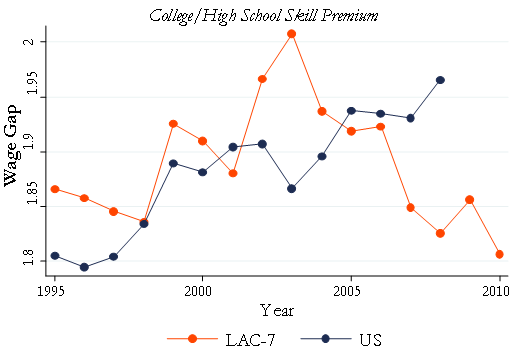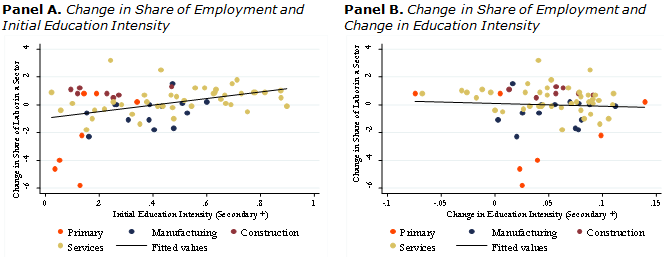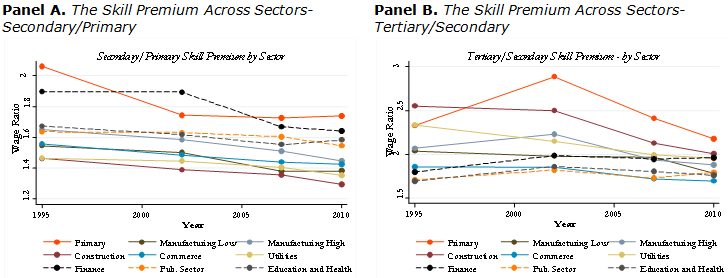Martes 10 de junio de 2014
Wage compression and the decline in inequality in Latin America: Good or bad?
Fuente:
Vox Eu
Autor:
Eduardo Levy Yeyati, Samuel Pienknagura
Wage compression and the decline in inequality in Latin America: Good or bad?
Eduardo Levy Yeyati, Samuel Pienknagura,´┐Ż10 June 2014
Latin America’s inequality has fallen, driven by a reduction in the educational wage premium. This column discusses potential driving forces behind this phenomenon and argues that while this is a positive outcome, it may reflect a deeper malaise. A preliminary evaluation suggests that supply changes are more important than de-industrialisation. But lacklustre PISA scores support a more dismal hypothesis. The premium decrease may mirror a decline in education quality.
Unlike most of the developed world, Latin America has seen a notable decline in income inequality in the last decade.
Labour earnings (as opposed to non-labour earnings in the form of transfers) were the main driver behind this equalisation.
More than half of the reduction in income inequality can be attributed to a compression of the ‘education premium’.
Here, education premium is taken to be the wage differential between workers with higher levels of education relative to those with lower levels of education (Lopez-Calva and Lustig 2010, de la Torre, Messina, and Pienknagura 2012). The contrasts sharply with what we observe in the US and other high income economies (Figure 1).1
Figure 1. Skill premium in LAC-7 and the US

Notes: LAC-7: Argentina, Brazil, Chile, Colombia, Mexico, Peru, and Uruguay. Skill premia for LAC are estimated according to equation (1) in footnote 1. The Tertiary/Secondary skill premium for the US is taken from Acemoglu and Autor (2011). Source: de la Torre, Levy Yeayi and Pienknagura (2013) and Acemoglu and Autor (2011).
Is this good or bad news for the region?
On one hand, we could emphasise the equity aspect and regard the result as an achievement.
On the other, we could argue that a smaller education premium undermines the incentives to study and to accumulate human capital.
The question, however, exceeds a simple yes-or-no answer, since the observed wage compression could be driven by a number of forces, both good and bad. In de la Torre, Levy Yeyati, and Pienknagura (2013), we discussed three potential drivers behind Latin America´┐Żs wage-induced decline in inequality:
Changes in the composition of the labour force by education group;
Excess supply of skills; and
Bad quality of education.
Is it the composition of the labour force?
Today, more families in Latin America have access to the educational system than ever before. Many children have higher educational attainment than their parents (Figure 2), especially those coming from the lower end of the income distribution. To the extent that, for a given educational level, children of poorer households have on average a lower performance, or have unobserved characteristics that make them earn lower wages than their peers from richer households, broader access to education can adversely influence the education premium.2´┐ŻMore precisely, if medium and higher education is composed today of a larger share of students from the lower end of the income distribution, one should expect the wage received by the average worker with secondary or tertiary education to be lower today than it was in the past. Moreover, as time progresses and access to education of students from poorer household tilts in favour of higher levels of education, one should expect the tertiary/secondary and the secondary/primary wage premia to flatten over time.
Figure 2. Supply of education across regions

Notes: LAC-7 & Uruguay: Argentina, Brazil, Chile, Colombia, Mexico, Peru, Uruguay, and Venezuela. SEA MICs: Indonesia, Malaysia, Philippines, South Korea, and Thailand.EE MICs: Estonia, Hungary, Poland, and Slovakia. PCEs: Australia, Canada, New Zealand, Norway, and Sweden. AT MICs: South Korea, Singapore, and Thailand. Source: Barro-Lee (2010) and de la Torre, Levy Yeyati, and Pienknagura (2013)
This hypothesis is consistent with the timing of the decline in tertiary/secondary and the secondary/wage premium: the latter starts falling in the 1990s while the former does so only in the early 2000s, which is consistent with the progressive access of individuals from poorer households to higher levels of education (Figure 3). Similarly, the decline appears to have started in the late 90s within the younger age group, only to show up in older age groups by the mid-2000s (Figure 4, Panels A and B).
Figure 3. Skill premia in LAC-7

Notes: LAC-7: Argentina, Brazil, Chile, Colombia, Mexico, Peru, and Uruguay. Skill premia for LAC are estimated according to equation (1) in footnote 1. Source: de la Torre, Levy Yeyati, and Pienknagura (2013).
Figure 4. The skill premium by age group in LAC-7

Notes: Countries in LAC-7include Argentina, Brazil, Chile, Colombia, Mexico, Peru, and Uruguay. Salaried workers. Skill-premia are calculated according to equation (1) in footnote 1. Source: de la Torre, Levy Yeyati, and Pienknagura (2013).
Note that to the extent that a lower education premium is due to more people from lower socio-economic status being able to attain higher education levels than in the past, this outcome should be regarded as good news. If this were the case, one would expect the returns on education to be constant over time once we control for all the socio-economic variables associated with academic and job performance (many of which are not included in standard wage regressions). In other words, performance-adjusted returns on education – and, as a result, incentives to study – remain intact as the decline in the education premium would be the statistical result of a more inclusive educational system.
Is it the excess supply (or insufficient demand) of skills?
A second hypothesis has to do with changes in the equilibrium between the supply and demand for workers with higher education. For example, countries that move towards the production of goods with low-skill content, or more intensive in low-skilled workers (for example, a growing importance of unprocessed commodities exports due to favourable terms of trade, at the expense of labour-intensive manufactures and services) are expected to see a contraction in the demand for skills and, over time, a decline in the education premium. Under this hypothesis, we should see a decline in the share of the labour force (and a deeper wage compression) in skill-intensive sectors relative to the rest.3´┐ŻHowever, the evidence fails to confirm the story:
Sectors with higher education intensity grew comparatively more, contradicting a shift towards low-skill sectors (Figure 5, Panels A and B).
While the correlation between skills and wage remained stable (Figure 6, Panel A), the wage compression was more apparent in low-skilled sectors (Figure 6, Panel B).
Figure 5. Change in labour share and education: Levels and changes by sector

Notes: Each dot in the scatter plots represents a pair of change in relative share of employment and initial education intensity or the change in education intensity for each of the 63 country-sector combinations (7 countries; 9 sectors). Countries include Argentina, Brazil, Chile, Colombia, Mexico, Peru, and Uruguay. Sectors are defined as Timmer and de Vries (2007). Labour shares are measured as the fraction of the labour force working in a given sector. Education intensity is measured as the share of workers in a given sector with a high school degree or a college degree. Changes are measured between in the time span between 2002 and 2010. Source: de la Torre, Levy Yeyati, and Pienknagura (2013).
Figure 6. Wages, education, and the skill premium across sectors

Notes: In Panel A, each dot in the scatter plots represents a pair of relative wage change and initial education intensity or the change in education intensity for each of the 63 country-sector combinations (7 countries; 9 sectors). Countries include Argentina, Brazil, Chile, Colombia, Mexico, Peru, and Uruguay. Sectors are defined as Timmer and de Vries (2007). Relative wages are measured as the ratio of the average wage in a given sector and the average wage in the economy. Education intensity is measured as the share of workers in a given sector with a high school degree or a college degree. Changes are measured between in the time span between 2002 and 2010. In Panel B, sectoral skill premia is estimated country by country according to equation (1) in footnote 1.Source: de la Torre, Levy Yeyati, and Pienknagura (2013).
A breakdown of the evolution of the premium in individual sectors point in the same direction: the fall in wage differentials is not concentrated in manufactures (Figure 7, Panels A and B). Indeed, the de-industrialisation story (commodity exports killing industrial activity) needs another qualification, since the most skill-intensive sector, and the one that grew the most, is not manufactures but services.
Figure 7. The skill premium across sectors

Notes: Sectoral skill premia in Panels A and B are estimated country by country according to equation (1) in footnote 1.Countries include Argentina, Brazil, Chile, Colombia, Mexico, Peru, and Uruguay. Sectors are defined as Timmer and de Vries (2007). Source: de la Torre, Levy Yeyati, and Pienknagura (2013).
Alternatively, a country that experiences an increase in the supply of skilled labour (more workers with secondary and tertiary degrees) would also see a decline in the education premium if everything else is kept constant. Here, the evidence is more supportive: country by country, the expected negative correlation between relative supply of skills and the skill premium seems to verify (Figure 8, Panels A and B).
Figure 8. Supply factors

Notes: LAC-7 & Uruguay: Argentina, Brazil, Chile, Colombia, Mexico, Peru, Uruguay, and Venezuela. In Panels A and B each color represents a LAC-7 country and each dot represents a (skill premium, relative skill supply) pair. Skill-premia is estimated according to equation (1) in footnote 1. Source: Barro-Lee (2010) and de la Torre, Levy Yeyati, and Pienknagura (2013).
Is it poor education quality?
A third hypothesis argues that the decline in the education premium has to do with a worsening of the quality of the educational system. We interpret quality broadly, from the effective number of hours taught at educational institutions, to the quality of teachers, including the match between the academic curricula and the actual skills demanded in the labour market. Because of the complex nature of what is comprised in the definition of quality, this is perhaps the hardest hypothesis to test (for the same reason, efforts to assess the quality of Latin America’s educational systems have considerable returns from a policymaker´┐Żs perspective).
What this hypothesis suggests is that if the performance of a student with tertiary and secondary education today is lower due to a worsening of the quality of education, the relative rewards of education will also be lower. Note that this hypothesis differs from the first one in that the lower performance is not driven by a low-income origin, or by a more lenient education standard to accommodate these new entrants but rather by lower performance in general – for example, because of anachronistic curricula or ill-prepared and less effective teachers and professors. In this case, the lower education premium would not reflect a decline in the value of performance-adjusted education, it would simply reflect a decline in effective skills as measured in the labour market.
And the winner is …
Should Latin America regard this wage-driven progress in reducing inequality as an achievement or as a source of concern? Are returns to education lower today than they were before? While assessing quantitatively the relative importance of the many forces behind the decline of Latin America’s education premium is challenging, a preliminary evaluation would de-emphasise the negative de-industrialisation story in favour of the more positive composition and excess supply hypotheses. That said, the lacklustre performance of the region in standard skill tests such as PISA supports a priori the more dismal hypothesis – that the decline in the skill premium mirrors a decline in education quality.
References
Acemoglu, D and D Autor (2011), “Skills, Tasks, and Technologies: Implications for Employment and Earnings,”´┐ŻHandbook of Labour Economics 4.
de la Torre A, E Levy Yeyati and S Pienknagura (2013),´┐ŻLatin America and the Caribbean as Tailwinds Recede : In Search of Higher Growth, LAC Semiannual Report, World Bank, Washington, DC, April.
de la Torre, M and S Pienknagura (2012),´┐ŻThe Labour Market Story Behind Latin America’s Transformation, LAC Semiannual Report, World Bank, Washington, DC, October.
Lopez-Calva, L F and N Lustig (eds.) (2010),´┐ŻDeclining Inequality in Latin America: A Decade of Progress?, Washington, DC: Brookings Institution Press.
Timmer, M and G de Vries (2007). “A Cross-Country Database for Sectoral Employment and Productivity in Asia and Latin America, 1950-2005,” GGDC Research Memorandum GD-98, Groningen Growth and Development Center, University of Groningen.
1´┐ŻTo estimate the education premium, we use an augmented Mincer regression pioneered by Katz and Murphy (1992) and vastly used in the literature:´┐Ż
ln(wageit) =´┐Żβ0´┐Ż+´┐ŻβP´┐Ż(No Secondaryit) +´┐ŻβT´┐Ż(Tertiaryit) +´┐ŻγXit´┐Ż+´┐Żvit; (1)
where´┐ŻNo Secondaryit´┐Żis a dummy variable which takes value 1 if individual i has no High School degree at time t,´┐ŻTertiaryit´┐Żis a dummy variable which takes value 1 if individual i has at least a College degree at time t, and´┐ŻXit´┐Żincludes sector fixed effects in addition to the controls mentioned above. In addition, we use a 10 sector classification similar to the one in Timmers and de Vrie (2007). In this context´┐ŻβT´┐Żcaptures the additional wage received by a College graduate relative to a High School graduate and´┐Ż-βP´┐Żmeasures the additional wage received by a High School graduate relative to an individual with no High School degree.´┐Ż
Depending on the exercise we perform we run 5 variations of equation (1):
(1.1) Estimates (1) country by country, year by year.
(1.2) Estimates (1) year by year pooling all LAC-7 & Uruguay countries together and controlling for country dummies.
(1.3) Estimates (1) sector by sector, year by year, pooling all LAC-7 & Uruguay countries together and controlling for country dummies.
(1.4) Estimates (1) country by country, year by year, and sector by sector.´┐Ż
(1.5) Estimates (1) age group by age group, year by year pooling all LAC-7 countries and Uruguay and controlling for country dummies, where we define 3 age groups (25-34, 35-44, 45+).
2 For example, many studies show that caregivers from richer households spend more resources (time and money) in activities that foster early childhood development. This can have an impact on the academic performance of children and on the compensation received in the labour market.
3 Note that, unlike in the case of insufficient demand, the excess supply of skills (and the narrow wage differential) may foster skill-intensive activities in the future, undoing the wage compression.
´┐Ż
´┐Ż
